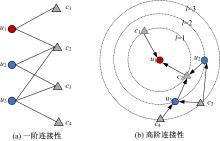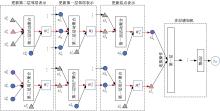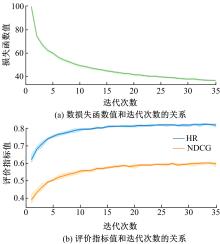Journal of Jilin University(Engineering and Technology Edition) ›› 2021, Vol. 51 ›› Issue (1): 278-284.doi: 10.13229/j.cnki.jdxbgxb20200068
Recommending activity to users via deep graph neural network
Xiao-hui WEI1,2( ),Bing-yi SUN1,2,Jia-xu CUI1,2
),Bing-yi SUN1,2,Jia-xu CUI1,2
- 1.College of Computer Science and Technology,Jilin University,Changchun 130012,China
2.Key Laboratory of Symbol Computation and Knowledge Engineering of Ministry of Education,Jilin University,Changchun 130012,China
CLC Number:
- TP301.6
| 1 | Liu X, He Q, Tian Y, et al. Event-based social networks: linking the online and offline social worlds[C]∥Proceedings of the 18th ACM SIGKDD International Conference on Knowledge Discovery and Data Mining, Beijing, China, 2012: 1032-1040. |
| 2 | Qiao Z, Zhang P, Cao Y, et al. Combining heterogenous social and geographical information for event recommendation[C]∥Proceedings of the Twenty-Eighth AAAI Conference on Artificial Intelligence, Quebec, Canada, 2014: 145-151. |
| 3 | Macedo A Q, Marinho L B, Santos R L T. Context-aware event recommendation in event-based social networks[C]∥Proceedings of the 9th ACM Conference on Recommender Systems, Vienna, Austria, 2015: 123-130. |
| 4 | Pham T, Li X, Cong G, et al. A general graph-based model for recommendation in event-based social networks[C]∥IEEE 31st International Conference on Data Engineering, Seoul, South Korea, 2015: 567-578. |
| 5 | Wu X, Dong Y, Shi B, et al. Who will attend this event together? event attendance prediction via deep LSTM networks[C]∥ Proceedings of the 2018 SIAM International Conference on Data Mining, San Diego, CA, USA, 2018: 180-188. |
| 6 | 董立岩, 王越群, 贺嘉楠, 等. 基于时间衰减的协同过滤推荐算法[J]. 吉林大学学报:工学版, 2017, 47(4): 1268-1272. |
| Dong Li-yan, Wang Yue-qun, He Jia-nan, et al. Collaborative filtering recommendation algorithm based on time decay[J]. Journal of Jilin University (Engineering and Technology Edition), 2017, 47(4): 1268-1272. | |
| 7 | Hamilton W L, Ying R, Leskovec J. Representation learning on graphs: methods and applications[J]. arXiv:1709.05584, 2017: 1-24. |
| 8 | Rendle S, Freudenthaler C, Gantner Z, et al. BPR: bayesian personalized ranking from implicit feedback[C]∥ Proceedings of the twenty-fifth Conference on Uncertainty in Artificial Intelligence, Montreal, QC, Canada, 2009: 452-461. |
| 9 | Wang H, Terrovitis M, Mamoulis N. Location recommendation in location-based social networks using user check-in data[C]∥Proceedings of the 21st ACM SIGSPATIAL International Conference on Advances in Geographic Information Systems, Orlando, Florida, USA, 2013: 364-373. |
| 10 | Jiang X, Sun X, Zhuge H. Towards an effective and unbiased ranking of scientific literature through mutual reinforcement[C]∥Proceedings of the 21st ACM International Conference on Information and Knowledge Management, Maui, HI, USA, 2012: 714-723. |
| 11 | Thomas N K, Max W. Semi-Supervised classification with graph convolutional networks[C]∥The 5th International Conference on Learning Representations, Toulon, France, 2017. |
| 12 | Hamilton W, Ying R, Leskovec J. Inductive representation learning on large graphs[C]∥Advances in Neural Information Processing Systems, Long Beach, CA, USA, 2017: 1024-1034. |
| 13 | Berg R V D, Kipf T, Welling M. Graph convolutional matrix completion[C]∥Proceedings of the 24th ACM SIGKDD International Conference on Knowledge Discovery and Data Mining, London, UK, 2018. |
| 14 | Wang X, He X, Wang M, et al. Neural graph collaborative filtering[C]∥Proceedings of the 42nd International ACM SIGIR Conference on Research and Development in Information Retrieval, Paris, France, 2019: 165-174. |
| 15 | He X, Liao L, Zhang H, et al. Neural collaborative filtering[C]∥Proceedings of the 26th International Conference on World Wide Web, Perth, Australia, 2017: 173-182. |
| 16 | Kingma D, Ba J. Adam: a method for stochastic optimization[C]∥The 3rd International Conference for Learning Representations, San Diego, USA, 2015. |
| 17 | Bayer I, He X, Kanagal B, et al. A generic coordinate descent framework for learning from implicit feedback[C]∥Proceedings of the 26th International Conference on World Wide Web, Perth, Australia, 2017: 1341-1350. |
| [1] | LI Jun, LI Xiong-fei, DONG Yuan-fang, ZHAO Hai-ying. New performance evaluation method for classifier [J]. 吉林大学学报(工学版), 2012, 42(02): 463-468. |
|
||





